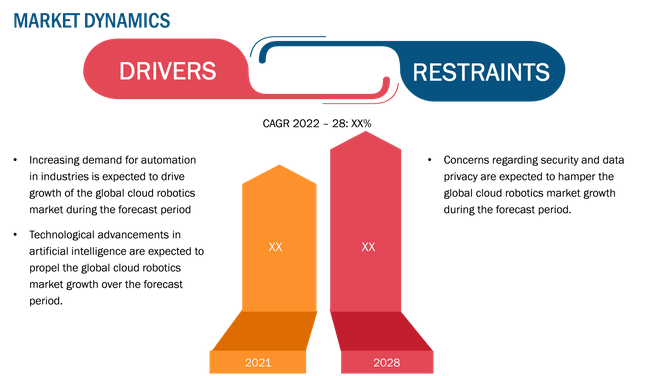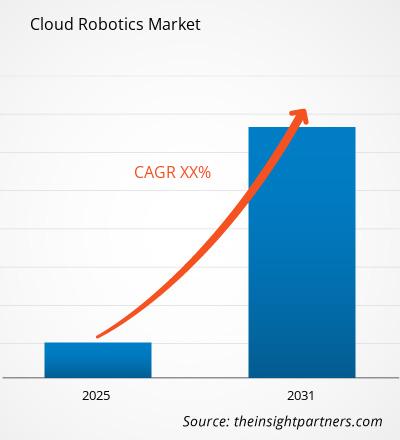MARKTÜBERBLICK
Die nahtlose Integration von Robotik und Cloud Computing, Internet-Technologie und Cloud-Speicher werden als Cloud-Robotik bezeichnet. Die Lernfähigkeit von Robotern wird durch Cloud-Robotik verbessert. Es ermöglicht Robotern, die enormen Rechen-, Speicher- und Kommunikationsressourcen aktueller Rechenzentren zu nutzen. Darüber hinaus können Roboter das schnelle Wachstum der Datenübertragungsraten nutzen, um Aktivitäten auszulagern, die keine strengen Echtzeitanforderungen erfordern. Das Ergebnis ist ein intelligenter Roboter mit einem cloudbasierten „Gehirn“ ist erreichbar. Die Wissensdatenbank, das Rechenzentrum, Deep Learning, Aufgabenplaner und andere Komponenten des Gehirns sind alle enthalten. Datenerfassung mit Hilfe eines Roboters, Verarbeitung der erfassten Daten auf Cloud-Servern, Anwendung der verarbeiteten Daten und Cloud-Robotik sind vier wesentliche Roboterprozesse.
MARKTUMFANG UND BERICHTSMERKMALE
Unser Bericht zur „Globalen Cloud-Robotik-Marktanalyse bis 2031“ fasst eine detaillierte Zusammenfassung zusammen Marktanalyse zu Schlüsselsegmenten wie Komponente, Bereitstellungsmodell, Servicemodell und Vertikale des Cloud-Robotik-Marktes sowie eine detaillierte statistische und qualitative Analyse nach geografischen Gesichtspunkten, die fünf Schlüsselregionen und mehrere Länder abdeckt. Als Teil der qualitativen Analyse bietet der Bericht eine Bewertung wichtiger Marktdynamiken wie vorherrschender Markttreiber, wichtiger Herausforderungen und Chancen, die den Weg für zukünftige Entwicklungen ebnen. Darüber hinaus bietet unsere Analyse der wichtigsten Wettbewerber einen strategischen Standpunkt zu den Marktinitiativen, eine SWOT-Analyse und Highlights zu den Produkt- und Serviceentwicklungen der Akteure.
MARKTSEGMENTIERUNG
Global Cloud Robotikmarkt – Nach Komponente
- •Software•< span style="Schriftgröße: 10pt; Schriftfamilie: Verdana, Genf, serifenlos;">Dienste
Globaler Markt für Cloud-Robotik – Nach Bereitstellungsmodell
- •Privat• Öffentlich•Hybrid
Globaler Markt für Cloud-Robotik – Nach Servicemodell
- •SaaS• PaaS•IaaS
Globaler Markt für Cloud-Robotik – Nach Vertikal
- •Industrial Cloud Robotics,• Professional Service Cloud Robotics•Domestic Service Cloud Robotics.
MARKET DYNAMICS

REGIONALE EINBLICKE
Der Bericht bietet einen detaillierten Überblick über die Branche, einschließlich qualitativer und quantitativer Informationen. Es bietet einen Überblick und eine Prognose des globalen Marktes basierend auf verschiedenen Segmenten. Es bietet auch Marktgrößen- und Prognoseschätzungen für die Jahre 2021 bis 2031 in Bezug auf fünf Hauptregionen, nämlich: Nordamerika, Europa, Asien-Pazifik (APAC), Naher Osten und Afrika (MEA) sowie Südamerika. Der Cloud-Robotik-Markt nach Regionen wird später nach jeweiligen Ländern und Segmenten unterteilt. Der Bericht umfasst die Analyse und Prognose von 18 Ländern weltweit sowie den aktuellen Trend und die in der Region vorherrschenden Chancen.
Der Bericht analysiert Faktoren, die den Markt sowohl auf der Nachfrage- als auch auf der Angebotsseite beeinflussen, und bewertet weiter die Marktdynamik, die den Markt während des Prognosezeitraums beeinflusst, d. h. Treiber, Beschränkungen, Chancen und zukünftige Trends. Der Bericht bietet außerdem eine umfassende Schädlingsanalyse für alle fünf Regionen, nämlich: Nordamerika, Europa, APAC, MEA und Südamerika nach Bewertung politischer, wirtschaftlicher, sozialer und technologischer Faktoren, die den Cloud-Robotik-Markt in diesen Regionen beeinflussen.
MARKTSPIELER
Der Bericht behandelt wichtige Entwicklungen auf dem Cloud-Robotik-Markt als organische und anorganische Wachstumsstrategien. Verschiedene Unternehmen konzentrieren sich auf organische Wachstumsstrategien wie Produkteinführungen, Produktzulassungen und andere wie Patente und Veranstaltungen. Zu den auf dem Markt beobachteten anorganischen Wachstumsstrategien gehörten Akquisitionen sowie Partnerschaften und Partnerschaften. Kooperationen. Diese Aktivitäten haben den Weg für die Erweiterung des Geschäfts und des Kundenstamms der Marktteilnehmer geebnet. Aufgrund der steigenden Nachfrage auf dem Weltmarkt werden den Marktteilnehmern im Cloud-Robotik-Markt künftig lukrative Wachstumschancen erwartet.
Der Bericht enthält auch die Profile wichtiger Unternehmen sowie deren SWOT-Analyse und Marktstrategien im Cloud-Robotik-Markt. Darüber hinaus konzentriert sich der Bericht auf führende Branchenakteure mit Informationen wie Firmenprofilen, angebotenen Komponenten und Dienstleistungen, Finanzinformationen der letzten drei Jahre und den wichtigsten Entwicklungen in den letzten fünf Jahren.
- •Rockwell Automation, Inc.•KUKA AG•ABB Group•FANUC Corporation•Yaskawa Electric Corporation•Rapyuta Robotics Co Ltd.•Universal Robots A/S.•Calvary Robotics•Tech-Con Automation Inc.•Automation IG.
HIGHLIGHTS DES BERICHTS
Unser Bericht über den Cloud-Robotik-Markt deckt die folgenden Schlüsselparameter ab:
- • Umfassende Marktanalyse auf globaler, regionaler und Länderebene•Detaillierte PEST-Faktoren (politische, wirtschaftliche, soziale und technologische Faktoren), die sich auf den Markt in wichtigen geografischen Regionen wie Nordamerika, Europa, Asien-Pazifik, Naher Osten und Afrika auswirken Südamerika•Marktdynamik (Treiber, Einschränkungen, Chancen und zukünftige Trends) und Auswirkungsanalyse von Treibern und Einschränkungen auf kurze, mittlere und lange Sicht •Marktgröße und Prognosen in Bezug auf Umsatz; 2021 (historisch), 2021 (Basisjahr), 2022 – 28 (Prognosezeitraum)•Umfassende Marktsegmentierung und detaillierte regionale und länderspezifische Analyse von über 18 Ländern in 5 Schlüsselregionen•Wichtige Unternehmensprofile und Branchenlandschaft zur Bereitstellung aktueller Marktinitiativen und Wettbewerbslandschaft•Auswirkungen der COVID-19-Pandemie auf das Ökosystem und den Markt
Das engagierte Forschungs- und Analyseteam des Insight Partners besteht aus erfahrenen Fachleuten mit fortgeschrittener Statistikkompetenz und bietet verschiedene Anpassungsoptionen in der bestehenden Studie.
- Historische Analyse (2 Jahre), Basisjahr, Prognose (7 Jahre) mit CAGR
- PEST- und SWOT-Analyse
- Marktgröße Wert/Volumen – Global, Regional, Land
- Branche und Wettbewerbsumfeld
- Excel-Datensatz

Report Coverage
Revenue forecast, Company Analysis, Industry landscape, Growth factors, and Trends

Segment Covered
This text is related
to segments covered.

Regional Scope
North America, Europe, Asia Pacific, Middle East & Africa, South & Central America

Country Scope
This text is related
to country scope.
Trends and growth analysis reports related to Technology, Media and Telecommunications : READ MORE..
The List of Companies
1. Rockwell Automation, Inc.
2. KUKA AG
3. ABB Group
4. FANUC Corporation
5. Yaskawa Electric Corporation
6. Rapyuta Robotics Co Ltd.
7. Universal Robots A/S.
8. Calvary Robotics
9. Tech-Con Automation Inc.
10. Automation IG
The Insight Partners performs research in 4 major stages: Data Collection & Secondary Research, Primary Research, Data Analysis and Data Triangulation & Final Review.
- Data Collection and Secondary Research:
As a market research and consulting firm operating from a decade, we have published and advised several client across the globe. First step for any study will start with an assessment of currently available data and insights from existing reports. Further, historical and current market information is collected from Investor Presentations, Annual Reports, SEC Filings, etc., and other information related to company’s performance and market positioning are gathered from Paid Databases (Factiva, Hoovers, and Reuters) and various other publications available in public domain.
Several associations trade associates, technical forums, institutes, societies and organization are accessed to gain technical as well as market related insights through their publications such as research papers, blogs and press releases related to the studies are referred to get cues about the market. Further, white papers, journals, magazines, and other news articles published in last 3 years are scrutinized and analyzed to understand the current market trends.
- Primary Research:
The primarily interview analysis comprise of data obtained from industry participants interview and answers to survey questions gathered by in-house primary team.
For primary research, interviews are conducted with industry experts/CEOs/Marketing Managers/VPs/Subject Matter Experts from both demand and supply side to get a 360-degree view of the market. The primary team conducts several interviews based on the complexity of the markets to understand the various market trends and dynamics which makes research more credible and precise.
A typical research interview fulfils the following functions:
- Provides first-hand information on the market size, market trends, growth trends, competitive landscape, and outlook
- Validates and strengthens in-house secondary research findings
- Develops the analysis team’s expertise and market understanding
Primary research involves email interactions and telephone interviews for each market, category, segment, and sub-segment across geographies. The participants who typically take part in such a process include, but are not limited to:
- Industry participants: VPs, business development managers, market intelligence managers and national sales managers
- Outside experts: Valuation experts, research analysts and key opinion leaders specializing in the electronics and semiconductor industry.
Below is the breakup of our primary respondents by company, designation, and region:

Once we receive the confirmation from primary research sources or primary respondents, we finalize the base year market estimation and forecast the data as per the macroeconomic and microeconomic factors assessed during data collection.
- Data Analysis:
Once data is validated through both secondary as well as primary respondents, we finalize the market estimations by hypothesis formulation and factor analysis at regional and country level.
- Macro-Economic Factor Analysis:
We analyse macroeconomic indicators such the gross domestic product (GDP), increase in the demand for goods and services across industries, technological advancement, regional economic growth, governmental policies, the influence of COVID-19, PEST analysis, and other aspects. This analysis aids in setting benchmarks for various nations/regions and approximating market splits. Additionally, the general trend of the aforementioned components aid in determining the market's development possibilities.
- Country Level Data:
Various factors that are especially aligned to the country are taken into account to determine the market size for a certain area and country, including the presence of vendors, such as headquarters and offices, the country's GDP, demand patterns, and industry growth. To comprehend the market dynamics for the nation, a number of growth variables, inhibitors, application areas, and current market trends are researched. The aforementioned elements aid in determining the country's overall market's growth potential.
- Company Profile:
The “Table of Contents” is formulated by listing and analyzing more than 25 - 30 companies operating in the market ecosystem across geographies. However, we profile only 10 companies as a standard practice in our syndicate reports. These 10 companies comprise leading, emerging, and regional players. Nonetheless, our analysis is not restricted to the 10 listed companies, we also analyze other companies present in the market to develop a holistic view and understand the prevailing trends. The “Company Profiles” section in the report covers key facts, business description, products & services, financial information, SWOT analysis, and key developments. The financial information presented is extracted from the annual reports and official documents of the publicly listed companies. Upon collecting the information for the sections of respective companies, we verify them via various primary sources and then compile the data in respective company profiles. The company level information helps us in deriving the base number as well as in forecasting the market size.
- Developing Base Number:
Aggregation of sales statistics (2020-2022) and macro-economic factor, and other secondary and primary research insights are utilized to arrive at base number and related market shares for 2022. The data gaps are identified in this step and relevant market data is analyzed, collected from paid primary interviews or databases. On finalizing the base year market size, forecasts are developed on the basis of macro-economic, industry and market growth factors and company level analysis.
- Data Triangulation and Final Review:
The market findings and base year market size calculations are validated from supply as well as demand side. Demand side validations are based on macro-economic factor analysis and benchmarks for respective regions and countries. In case of supply side validations, revenues of major companies are estimated (in case not available) based on industry benchmark, approximate number of employees, product portfolio, and primary interviews revenues are gathered. Further revenue from target product/service segment is assessed to avoid overshooting of market statistics. In case of heavy deviations between supply and demand side values, all thes steps are repeated to achieve synchronization.
We follow an iterative model, wherein we share our research findings with Subject Matter Experts (SME’s) and Key Opinion Leaders (KOLs) until consensus view of the market is not formulated – this model negates any drastic deviation in the opinions of experts. Only validated and universally acceptable research findings are quoted in our reports.
We have important check points that we use to validate our research findings – which we call – data triangulation, where we validate the information, we generate from secondary sources with primary interviews and then we re-validate with our internal data bases and Subject matter experts. This comprehensive model enables us to deliver high quality, reliable data in shortest possible time.



 Get Free Sample For
Get Free Sample For